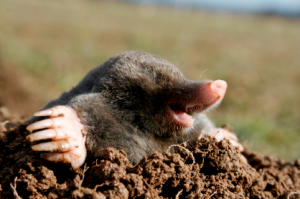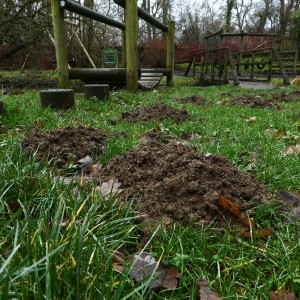We have a fascination with moles in our culture from Moley in ‘wind in the willows’ to the hit song ‘mole in a hole’ form the legendary Jamaican / British vocal group ‘Southlanders’. But when the mound forming menaces run amuck in our gardens what should we do? With mole control methods including trapping, poisoning and flushing out. I wonder if such drastic methods are really necessary?

Those of you that have visited our walled garden over the last few weeks would have noticed signs of our new residents. At last count, there were 72-molehills in our play area alone. Not mentioning the other territory in the vegetable garden.
I have to admit I have a soft spot for the European mole, or Talpa europaea to give it its posh name. So before I take any action I thought I should investigate this subterranean mammal to discover whether it is the velvety villain or the blind burrowing buddy of the gardener.

Very few of us get to see one of these dastardly diggers up close (and alive) even though they are one of Britons most common mammals with an estimated 40million living in the UK. The most common feature of the Moles presence is, of course, is the famous molehill that let us all know about the presence of this tiny creature. Molehills being the results of the mole’s rather impressive digging abilities.
It is reckoned that an average mole can dig up to 30 meters in a day with their powerful front paws, which I’m sure all you gardeners will agree is no small feat. Mole tunnels consist of passageways just below the surface that are used to trap their food (manly earthworms) and deeper tunnels that are used for nesting. The solitary animals roam under our lawns on their lonesome fulfilling there ferocious appetite by consuming their own body weight in food every day.

So what actual damage do they do to the garden? Apart from disrupting peoples prized lawns. I have found it difficult to find any negatives about having moles guest in our gardens. Some people claim that they can undermine plants, severing roots, and killing, or weaken them, but I have never experienced this myself. It could also be argued that they eat a lot of earthworms which are undoubtedly a gardeners friend, but again there seem to be plenty in the secret garden to go round. So I think the arguments for disliking moles are weak, to say the least.
With the consideration that we work had in our walled garden to encourage and look after wildlife, it would seem a bit selective to then discourage or terminate a native wild animal for the sake of preventing a few mounds of earth.
So with a shovel in hand and wheelbarrow in tow, I will only be managing the molehills and not the moles. Making use of the loamy tailings for the making potting compost. Thus for the foreseeable future, I will be leaving Moley alone to do what he does best, and dig side-by-side with a continued fondness and professional respect.

I have been enjoying January and February in the garden. It is a great month for standing back and observing the bare bones structure of the garden, and to make plans for the coming year. Already the garden seems to be waking up from a very short slumber. The snowdrops are stealing the show with there crisp white flowers, and the Hellebores are preparing for a good display, and the daff is coming in bloom. I am finding more and more colour and fragrance as the weeks’ pass. And the message is clear, I am going to be very busy, very soon.
Tony Vallance.


